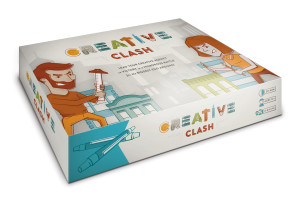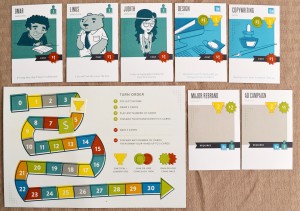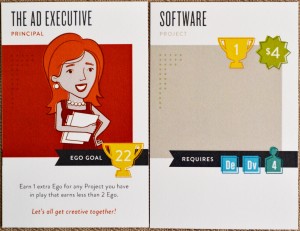Ever dreamt of owning your own creative agency? That is, hire employees, manage your money, complete projects, and deal with random events as they occur? If the answer is yes, then you’re in luck! “Creative Clash”, a fast-paced card game that will be launching soon on Kickstarter (as of 3/13/14), promises exactly that. In this case, players will be competing to complete their own individual “ego” goals before the others do. Before I get ahead of myself though, I’d like to thank principal and creative director Ryan Smoker for reaching out and providing me with a prototype copy. It’s important to stress that prototypes are often not reflective of the final version, making everything featured in this article (including the rules) subject to change.
My demo copy came with over a hundred cards, four player boards, and eight tokens. Eight of the aforementioned cards are labeled as “principal cards”…think of these as individual goal cards. At the beginning of the game, each player will receive one, face-up. These principal cards list an ego goal (victory point goal) along with a special ability that the player in question can observe throughout the course of the game. Each player also gets a player board and two tokens, the latter of which are used to track the “coin” and “ego” values on the former. Each player starts with zero ego and three coin. Finally, the nine to five deck (all the other cards) are shuffled and eight are dealt to each player. Players then discard down to five cards to form their starting hand.
A player’s turn order is relatively simple: 1) Collect Income, 2) Draw Two Cards, 3) Play Any Number Of Cards. With regard to the first phase, players will simply adjust the token on their income tracker based on the cards they have in front of them. Unlike more complex games like “Suburbia”, you won’t actually be earning physical coins or money based on your current income. As such, you’ll be adjusting your tracker downward when playing cards that have a cost associated with them. This makes the game a bit more family-friendly and simpler, in my opinion.
The real meat and potatoes of this game lies with the third phase (phase two is self-explanatory). The nine to five deck includes a number of different card types, including employees, projects, skills, stuff, persons, and events. Cards are played either near a player’s own board or near the board of an opponent. The kicker is that they all do different things…some reward the player with ego (needed to win the game) or income, while others put a crutch on other players, so to speak. While players aren’t limited to playing a certain number of cards on their turn, they may want to hold onto some and play them when they really need them. During this phase, you can also discard any number of cards to gain income at a ratio of 1:1.
I personally like the fact that there’s more than one way to earn ego, giving the game some strategic value. Players can spend income in most cases to play stuff cards, which provide a flat-out ego boost to your overall score. For all intents and purposes, that’s probably the easiest way to go. On the other hand, you can attempt to gain the prerequisites necessary to complete projects. Project cards, before they can be played, require that a player have a certain number of employees and skills. It costs money to play employees near your player board and attach skills to them, but the payoff in playing and completing a project card is usually worth the trouble.
Person and event cards do a good job in helping to mix things up a bit. The “King Stuff” person card, for example, rotates around the table based on who has the most stuff cards in play near their player board. The person who currently has it gains two extra ego. Other person cards grant the player special abilities, but a cost must be observed each time you make use of them. Event cards are a bit more random, one tasking players with playing “Rock-Paper-Scissors” to see who earns some bonus coins. There are a total of thirty-six person and event cards in the one hundred and seventeen nine to five deck, so they do come up frequently.
Despite the fact that the game is still under development, I thought that there was a good balance between the various cards available. I liked the fact that some cards granted and penalized coins on both a one turn or multiple turn basis. Part of the appeal of business sims, I feel, lies in the money management aspect of things. “Creative Clash” turned out to be no different in that regard. While I wasn’t physically earning any plastic/paper coins, there was a real sense of my net worth as I played cards from turn to turn. Some might not like not having a physical representation of their bank account (via coin pieces), but I was okay with it.
In the grand scheme of things, “Creative Clash” is a perfect example of how a game can be casual and family-friendly while at the same time feature some type of strategic element that will keep you thinking. It’s casual in the sense that it’s easy to learn and play, which is good for those easily intimidated by games with a business-sim theme. The variety of card types and the synergy between them, on the other hand, will give one pause to consider what the best move at the time will be. There are some cards that reference terms not suitable for younger children, but there is nothing inappropriately graphic when it comes to the card art. Overall, “Creative Clash” is an excellent card game worth supporting!
—
“Creative Clash” is expected to hit Kickstarter on March 18, 2014. You can learn more about and support the game by visiting its Kickstarter page, here:
https://www.kickstarter.com/projects/1807181349/creative-clash-a-card-game
—



